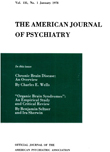HEREDITY IN THE FUNCTIONAL PSYCHOSES
Abstract
To date four methods have been devised for the study of heredity. The first is Galton's family history method. Several generations of clinical experience have shown that this method is fallacious because mere observation alone cannot differentiate hereditary from environmental causes. On the basis of their fallacious statistical studies, the Galtonians have come to incorrect conclusions such as the inheritability of rickets, tuberculosis and pellagra. It is evident that the mere recurrence of a certain trait in the same family does not prove that trait to be hereditary. This follows automatically from the fact that members of the same family have similar environments. Unfortunately, this obsolete family history method is often used today. The second method was introduced by Mendel. This a purely experimental technique which necessitates pure stock for the parent generation, a completely controlled environment, inbreeding of brother and sister and a sufficiently large number of F 2 progeny to bring out the characteristic Mendelian ratio. Only by the experimental demonstration of the F 2 ratio can this method prove a character to be hereditary. For functional psychoses none of the conditions necessary for a Mendelian experiment can be achieved in human beings. The method, therefore, can give us no information as to whether or not these psychoses are inherited. The third method widely used for the study of heredity in mental diseases is the combination method. This method seeks to find the characteristic F 2 Mendelian ratios in family histories. We have seen that these ratios appear only in certain stages of a very highly specialized experimental technique. Occasionally a characteristic ratio can be found in simple I-gene diseases like Huntington's chorea and polydactyly. It is a grave error to reason from this analogy that the discovery of a characteristic ratio in a few families necessarily proves the character to be hereditary. A casual inspection of family histories of mental patients shows that no such simple mechanism could possibly be involved. Goddard's classical error of trying to prove feeblemindedness to be hereditary by this method is a typical example of the uselessness of the method for psychiatric disorders. The fourth method is the study of the mental status of twins. Although the heredity is the same in identical twins, the mere discovery of two twins with the same mental disorder does not prove the mental disorder to be hereditary. Since twins are more likely to have similar environments than are ordinary individuals, similarities in environment seem to be the cause of such simultaneous appearance of functional psychoses. If heredity were the cause of the psychosis, it would be impossible for only one twin to be affected. In Rosanoff's study of 41 pairs of identical twins, only one twin was affected in 32 per cent of the pairs. This is substantial evidence against a hereditary etiology of schizophrenia. The other three groups of cases summarized in Fig. 7 are ordinary siblings. They have identical hereditary relationships. The declining double schizophrenia rate in these three groups (20 per cent, 10 per cent, 3 per cent) must be due to environmental difference.
Access content
To read the fulltext, please use one of the options below to sign in or purchase access.- Personal login
- Institutional Login
- Sign in via OpenAthens
- Register for access
-
Please login/register if you wish to pair your device and check access availability.
Not a subscriber?
PsychiatryOnline subscription options offer access to the DSM-5 library, books, journals, CME, and patient resources. This all-in-one virtual library provides psychiatrists and mental health professionals with key resources for diagnosis, treatment, research, and professional development.
Need more help? PsychiatryOnline Customer Service may be reached by emailing [email protected] or by calling 800-368-5777 (in the U.S.) or 703-907-7322 (outside the U.S.).



